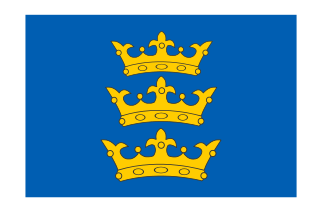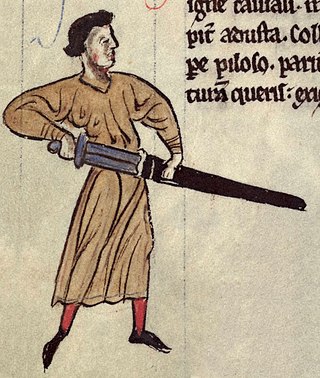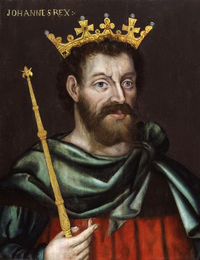
The Lordship of Ireland, sometimes referred to retroactively as Norman Ireland, was the part of Ireland ruled by the King of England and controlled by loyal Anglo-Norman lords between 1177 and 1542. The lordship was created following the Norman invasion of Ireland in 1169–1171. It was a papal fief, granted to the Plantagenet kings of England by the Holy See, via Laudabiliter. As the Lord of Ireland was also the King of England, he was represented locally by a governor, variously known as the Justiciar, Lieutenant, Lord Lieutenant or Lord Deputy.

Fingal is a county in Ireland. It is in the province of Leinster and is part of the Eastern and Midland Region. It is one of three successor counties to County Dublin, which was disestablished for administrative purposes in 1994. Its name is derived from the medieval territory of Scandinavian foreigners that settled in the area. Fingal County Council is the local authority for the county. In 2022 the population of the county was 329,000, making it the second most populated council in Dublin, and third most populous county in the state.
Richard de Clare, 2nd Earl of Pembroke, Lord of Leinster, Justiciar of Ireland, also known as Richard FitzGilbert, was an Anglo-Norman nobleman notable for his leading role in the Anglo-Norman invasion of Ireland. Like his father, Richard fitz Gilbert has since become commonly known by his nickname Strongbow, which may be a mistranscription or mistranslation of "Striguil".

The term Angevin Empire describes the possessions of the House of Plantagenet during the 12th and 13th centuries, when they ruled over an area covering roughly half of France, all of England, and parts of Ireland and Wales, and had further influence over much of the remaining British Isles. It may be described as an early example of a composite monarchy. The empire was established by Henry II of England, who succeeded his father Geoffrey Plantagenet as Duke of Normandy and Count of Anjou. Henry married Eleanor of Aquitaine in 1152, becoming her royal consort, and inherited his mother Empress Matilda's claim to the English throne, succeeding his rival Stephen in 1154. Although their title of highest rank came from the Kingdom of England, the Plantagenets held court primarily on the continent at Angers in Anjou, and at Chinon in Touraine.

Robert FitzStephen was a Cambro-Norman soldier, one of the leaders of the Norman invasion of Ireland, for which he was granted extensive lands in Ireland. He was a son of the famous Nest, daughter of Rhys ap Tewdwr, the last king of Deheubarth. His father was Nest's second husband, Stephen, Constable of Cardigan. Following the death of her first husband, Gerald de Windsor, her sons had married her to Stephen, her husband's constable for Cardigan. By Stephen, she had another son, possibly two; the eldest was Robert, and the younger may have been Hywel.

The history of Ireland from 1169–1536 covers the period from the arrival of the Cambro-Normans to the reign of Henry VIII of England, who made himself King of Ireland. After the Norman invasion of 1169–1171, Ireland was under an alternating level of control from Norman lords and the King of England. Previously, Ireland had seen intermittent warfare between provincial kingdoms over the position of High King. This situation was transformed by intervention in these conflicts by Norman mercenaries and later the English crown. After their successful conquest of England, the Normans turned their attention to Ireland. Ireland was made a lordship of the King of England and much of its land was seized by Norman barons. With time, Hiberno-Norman rule shrank to a territory known as the Pale, stretching from Dublin to Dundalk. The Hiberno-Norman lords elsewhere in the country became Gaelicised and integrated in Gaelic society.

The Anglo-Norman invasion of Ireland took place during the late 12th century, when Anglo-Normans gradually conquered and acquired large swathes of land from the Irish, over which the kings of England then claimed sovereignty, all allegedly sanctioned by the Papal bull Laudabiliter. At the time, Gaelic Ireland was made up of several kingdoms, with a High King claiming lordship over most of the other kings. The Norman invasion was a watershed in Ireland's history, marking the beginning of more than 800 years of direct English and, later, British, involvement in Ireland.
William FitzAldelm, FitzAdelm, FitzAldhelm, or FitzAudelin was an Anglo-Norman nobleman from Suffolk or North Yorkshire. He was the son of Adelm de Burgate, and an important courtier who took part in the Norman invasion of Ireland.

de Lacy is the surname of an old Norman family which originated from Lassy, Calvados. The family took part in the Norman Conquest of England and the later Norman invasion of Ireland. The name is first recorded for Hugh de Lacy (1020–1085). His sons, Walter and Ilbert, left Normandy and travelled to England with William the Conqueror. The awards of land by the Conqueror to the de Lacy sons led to two distinct branches of the family: the northern branch, centred on Blackburnshire and west Yorkshire was held by Ilbert's descendants; the southern branch of Marcher Lords, centred on Herefordshire and Shropshire, was held by Walter's descendants.

Hugh de Lacy, Lord of Meath, 4th Baron Lacy, was an Anglo-Norman landowner and royal office-holder. He had substantial land holdings in Herefordshire and Shropshire. Following his participation in the Norman Invasion of Ireland, he was granted, in 1172, the lands of the Kingdom of Meath by the Anglo-Norman King Henry II, but he had to gain control of them. The Lordship of Meath was then the most extensive liberty in Ireland.

Hugh de Lacy, 1st Earl of Ulster was an Anglo-Norman soldier and peer. He was a leading figure in the Norman invasion of Ireland in the 12th century, and was created Earl of Ulster in 1205 by King John of England.

Walter de Lacy was lord of Meath in Ireland. He was also a substantial land owner in Weobley, Herefordshire, in Ludlow, Shropshire, in Ewyas Lacy in the Welsh Marches, and several lands in Normandy. He was the eldest son of Hugh de Lacy, a leading Cambro-Norman baron in the Norman invasion of Ireland, and Rohese of Monmouth.

Theobald Walter was the first Chief Butler of Ireland. He also held the office of Chief Butler of England and was the High Sheriff of Lancashire for 1194. Theobald was the first to use the surname Butler of the Butler family of Ireland. He was involved in the Irish campaigns of King Henry II of England and John of England. His eldest brother Hubert Walter became the Archbishop of Canterbury and justiciar and Lord Chancellor of England.
Ratoath is a barony in County Meath. It comprises ten parishes and portion of two others viz Rathbeggan, Dunshaughlin, Kilbrew, Crickstown, Killegland, Cookstown, Donaghmore, Ratoath, and portions of Ballymaglasson and Trevit.
Meiler FitzHenry was a Cambro-Norman nobleman and Lord Chief Justice of Ireland during the Lordship of Ireland.
Thomas of Galloway, known in Gaelic sources as Tomás Mac Uchtraigh, was a Gall-Gaidhil prince and adventurer. The son of Lochlann, king of Galloway, Thomas was an active agent of his brother Alan of Galloway as well as the English and Scottish kings. When King John, the English monarch, decided that central and western Ulster were to be added to his dominions, he conscripted Thomas and Alan of Galloway to his aid, offering them much of later counties Antrim, Londonderry and Tyrone as incentive.
Aodh Méith or Áed Méith was a 13th-century king of Tír Eoghain. The son of Aodh an Macaoimh Tóinleasg, Aodh spent much of his career fighting off threats from Fir Manach, Tír Conaill and Galloway, as well as John de Courcy and the Lordship of Ireland. His involvement in Irish Sea politics may have seen him sponsor a Mac Uilleim claim to the Scottish throne, but this is unclear.
The Lordship of Meath was an extensive seigneurial liberty in medieval Ireland that was awarded to Hugh de Lacy by King Henry II of England by the service of fifty knights and with almost royal authority. The Lordship was roughly co-extensive with the medieval kingdom of Meath. At its greatest extent, it included all of the modern counties of Fingal, Meath, Westmeath as well as parts of counties Cavan, Kildare, Longford, Louth and Offaly. The Lordship or fiefdom was imbued with privileges enjoyed in no other Irish liberty, including the four royal pleas of arson, forestalling, rape, and treasure trove.
Hugh Tyrrel, 1st Baron of Castleknock was an Anglo-Norman nobleman and crusader who played a prominent part in the Norman invasion of Ireland and took part in the Third Crusade.
Nicholas Devereux of Chanston (Vowchurch) was an Anglo-Norman nobleman living during the reigns of John and Henry III of England. The Devereux were a prominent knightly family along the Welsh Marches during the thirteenth century, and Nicholas Devereux was a key member of the retinue of Walter de Lacy, Lord of Meath.












